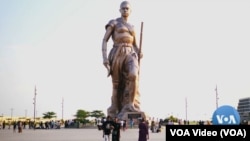The female warriors of the Kingdom of Dahomey are a touchpoint in the cultural history and a source of national pride for this West African nation. Their story was recently dramatized in the historical Hollywood film, "The Woman King” portrayed by Oscar-winning African-American actor, Viola Davis.
Since the statue was unveiled in the capital Cotonou by President Patrice Talon in July 2022, it has drawn visitors from all over the country.
“It’s a symbol of struggle, because in their time, it was almost unheard of to see women fighting instead of men and defending their territories,” said Yao Guillaume, an Ivorian tourist.
Agossou Chamien is a local resident. She said the female warriors were a force to reckon with, and extolled their relevance in Benin's history and culture..
“The Amazons fought for Benin, for Dahomey. They were fighting women and played important roles in the country. I am glad I came to see this statue. It is very beautiful,” she said.
However, a recent investigation by VOA's Korean Service has discovered that the statue was likely built by the Mansudae Art Studio in North Korea. The studio is famed for creating statues of the country’s dictators, and through its overseas projects arm, and monuments around the world.
Mansudae is currently under United Nations sanctions designed to stop North Korea’s leader Kim Jong Un from accessing foreign currency that could help finance the country’s nuclear weapons program.
The U.N. Security Council Sanctions Committee on North Korea, set up in 2006 to monitor the economic sanctions imposed on the country, does not speak publicly, to protect the identity of its members. But it provided VOA with the following written statement on its recent investigation into the statue.
“The Benin authorities’ response to the Panel’s questions (contained in that report) did not allay the Panel’s concerns that the construction of the statue had been a clear breach of UN sanctions against [North Korea], and that the monies thereby gathered by the Mansudae Group could have contributed to the continuing development of [North Korea]’s WMD programs,” it said.
VOA spoke to Benin's tourism and culture minister Babalola Jean-Michel Hervé Abimbola and presented VOA Korean’s evidence to him.
“It was designed by a Beninese artist called Julien Sinzogan, who is well-known and can be identified. Benin then turned to companies that specialize in bronze casting. As far as I’m concerned, it was made by China. But did they use Korean engineers? and from which Korea? I don't know. Only the foreign minister can say,” he said.
The VOA Korean investigation found the order for the statue was placed by Benin’s government with the Blue Dragon International Development Company, believed to be a Chinese front company for Mansudae. When probed for comments, the tourism and culture minister requested VOA to stop recording saying “This interview is no good. It must be stopped. I am not doing it.”
Even when sanctions are breached, the U.N. has little power to make the nations involved face consequences. Sanctions have so far proved ineffective in preventing North Korea from pursuing its nuclear weapons program.
North Korean authorities did not respond to VOA's request for comment.
Jiha Ham and VOA's Korean Service contributed to this article.




